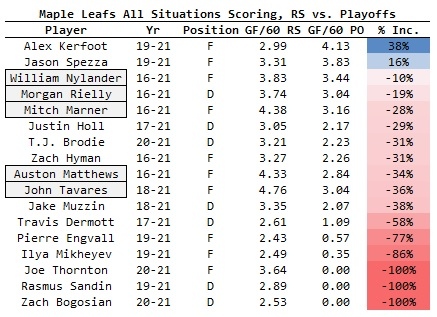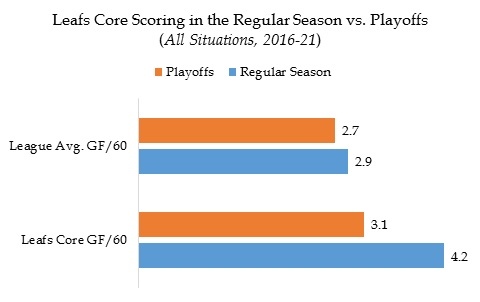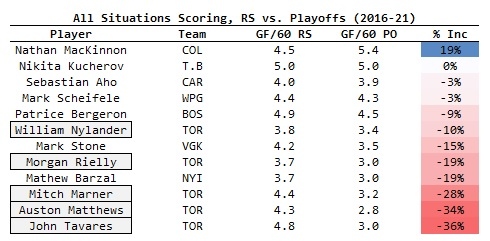May 31, 2021
Maple Leafs need more from core
Toronto’s core forwards may be dangerous, but time and time again we’ve see the group score considerably less in the playoffs than in the regular season, Travis Yost writes.
By Travis Yost

It’s starting to look gloomy in Toronto.
The Maple Leafs let a commanding series lead against an inferior opponent slip away over the weekend, and now find themselves in a tenuous spot. Montreal deserves endless credit for how they have been able to skate with Toronto in the series, ensuring all of the pressure heading into Game 7 will lay at the feet of Sheldon Keefe’s club.
The Maple Leafs have been here before – many times, in fact. That’s where some of the frustration from the fan base is boiling over. Five years ago, when the Maple Leafs were a fun and upstart team heading into David-versus-Goliath-type battles against the Boston Bruins, a tough opening-round loss would have been digestible. Here? Not so much.
In one breath, it’s hard to be too critical of the Maple Leafs this series. Over the first six games, Toronto has 52 per cent of the shots, 60 per cent of the expected goals, and have outscored the Canadiens 17 to 11. If you play that way over an extended period of time, you are going to win more often than not.
But former Florida Panthers scout Rhys Jessop pointed out something that’s impossible to ignore after Saturday night, and that’s the reality of what’s happening at the top of the Maple Leafs lineup. The team’s core forwards may be as dangerous as ever, but time and time again we’ve seen this group score considerably less in the playoffs than in the regular season.
It’s a huge concern because the Maple Leafs can’t rest their laurels on firm defensive play or indomitable goaltending over lengthy stretches. This team is built to outscore you, and they are good at doing that. But when the scoring isn’t there, the team is beatable.
It is true that scoring the playoffs, in relative terms, is quite difficult. Over the past five seasons, scoring has dropped in the postseason by about 7 per cent, some of that contributable to a reduction in power-play opportunities. But we are seeing much more than a 7 per cent drop-off here:

This trend is also true if you subset the data to just even-strength play. And that’s the problem here. The Leafs’ core is scoring three goals per 60 minutes of play in the playoffs, and if you just stared at that number long enough you could convince yourself that should be enough to get the job done.
But compare the Maple Leafs core in the regular season versus league averages to the playoffs versus league averages:

In both instances I can show that Toronto’s core is above average at generating goals. But this team is reliant on those players generating goals at a considerably higher rate than their peers. In the regular season, Toronto’s top-end scorers are 30 per cent deviant from league-average scoring; in the playoffs, that number drops to 12 per cent.
And though scoring in the postseason is certainly more difficult, we do not see this trend apply elsewhere. Let’s look at that same group of Maple Leafs skaters and compare them with some of the big names remaining in the playoffs, still analyzing that five-year horizon.
We see slowdowns in rate scoring, but look which group takes the biggest hit, and look which group’s playoff scoring is close to league average:

Players like Patrice Bergeron and Mark Stone see less offensive production, but they are also the two best defensive forwards in the game. Other players, like Nathan MacKinnon and Nikita Kucherov, have been more dangerous offensively in the playoffs, which is saying something. But all of these forwards are still scoring at high rates and are still creating net-goal advantages for their respective franchises. Toronto’s core is too, but at a substantially smaller rate.
Toronto’s core players are not playing poorly. But they are paid to steamroll teams. That’s their competitive advantage. Whenever their scoring peters out, the team looks a lot more mortal. That’s why we keep scratching our heads watching the Maple Leafs in the playoffs. They have always been good. But can they be good enough?
We are going to find out Monday night.

